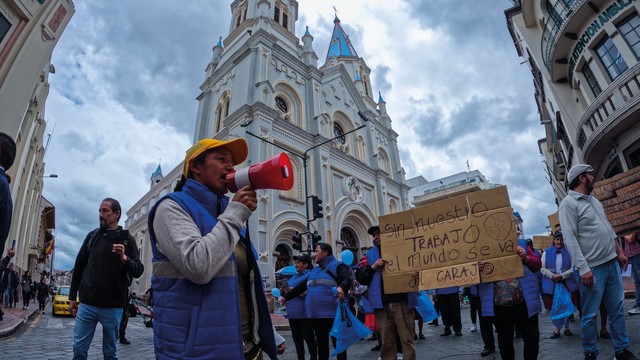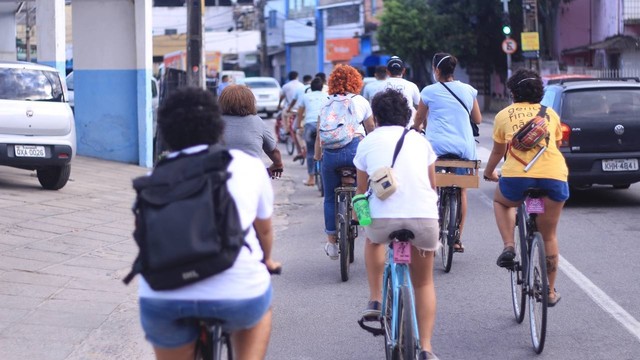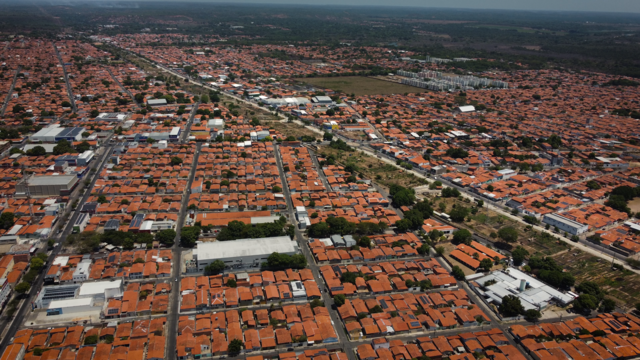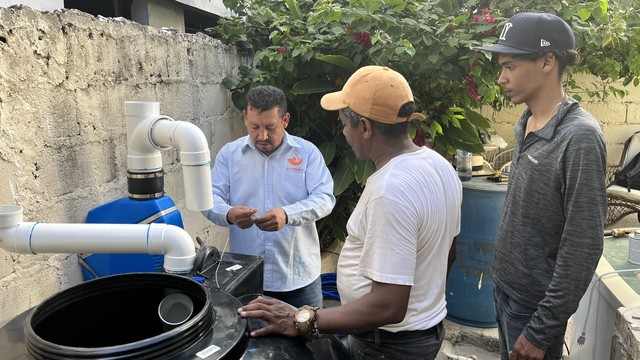Quito: sustainable transformation in Guápulo – nurturing nature in the heart of the city
The ‘CEES Makes its Mark’ project is transforming Quito’s Guápulo neighbourhood. At a cost of US$90,000 and with plans for a second phase, its energy efficiency, water management and waste reduction initiatives are benefiting 120 residents.

Aerial view of Eduardo de Mena lane, Guápulo, Quito (Photo: Rama Estudio)
As well as being the country’s most populous city, the Metropolitan District of Quito is where most political and financial activity takes place and the focus of investment, mainly in large-scale development projects. The city has historically been at risk of earthquakes and volcanic eruptions, as well as being affected by climate risks such as heavy rains in winter and devastating fires in summer.
Compounding these risks is the city’s increasing outward expansion, in some cases to high-risk areas. In response to this, the municipal government has taken forward a number of initiatives to reduce vulnerability and improve the quality of life of the city’s residents.
These include the Climate Action Plan (PACQ) (PDF in Spanish) launched in 2020, which establishes the priority strategies for achieving the international commitments set out in the Paris climate change agreement. A municipal bylaw, Metropolitan Ordinance 004 (PDF in Spanish), was enacted to regularise informal buildings by mandating the structural reinforcement of those buildings that require it and thus reduce their vulnerability to the risks affecting the area. An ecoefficiency bylaw, Metropolitan Ordinance 003 (PDF in Spanish), provides incentives for new building projects to adhere to sustainability criteria focusing on energy efficiency, reduced water use and waste management.
These and other urban planning measures have made Quito a point of reference for other cities in the country and the region. Quito’s climate action plan sets out the roadmap for making it a climate-neutral city with zero greenhouse gas emissions by 2050, by achieving three main objectives:
- Limiting the growth of the carbon footprint
- Boosting resilience and reducing social vulnerability through nature-based solutions, and
- Ensuring citizens’ health, wellbeing and quality of life.
Multiple sectors are working to make Quito a more sustainable city, with the municipal government focusing on the regulatory side and academia and the private sector also playing their part.
The Ecuador Sustainable Building Council (in Spanish), better known as CEES, brings these sectors together to design projects that promote sustainable buildings.
In 2022, CEES brought private companies, the municipal government and academics together to design a sustainability project for an urban area. The area chosen was the neighbourhood of Guápulo, with the project on Eduardo de Mena Lane. The aim of the “CEES Makes its Mark” project was to pioneer a number of sustainability strategies in one neighbourhood of the city, using participatory design processes together with the local community.
Catalina, neighbourhood residentThis was a great project. We all went along to see how we could help and what we could do together. We are a close-knit community in this neighbourhood
CEES makes its mark
Developed by CEES Urban Laboratories, the project came about as a result of a competition, called Neutral Footprint, to identify and implement a pilot plan for a selected area of Quito to become carbon-neutral and sustainable.
Architects, engineers and other urban development professionals were encouraged to present their ideas or projects. The proposal had to include innovative ways to achieve energy efficiency and save water, circular economy strategies or other alternatives, to be implemented in a neighbourhood of about 25 families and businesses, which would become a model for low greenhouse gas emissions and provide its residents with a good quality of life. This experimental site would therefore be Point Zero, a blueprint that could be replicated in other parts of the city.
The winning team, the architecture company Rama Estudio, had two months to design the project, and $90,000 and 240 days to implement it.
The “CEES Makes its Mark” project was implemented in the Guápulo neighbourhood, an urban area in the east of Quito’s city centre. This was originally an indigenous settlement that changed from being a village on the outskirts of the city to an urban neighbourhood characterised by its diverse community of artists, students and migrants. The neighbourhood is part of the city’s historical and heritage sector, with built-up zones adjacent to protected natural areas, and it is located on a steep mountainside.
Today, the neighbourhood has a close-knit, well-organised community and a volleyball court that functions as a public space for the whole community to use. The neighbourhood is next to a forest whose native species have been inventoried by the municipal government, with a view to rehabilitating it for public use.
The neighbourhood’s Eduardo de Mena Lane is home to 25 families, who came together to make this project a reality. On one side of the lane is the neighbourhood volleyball court, and on the other there is a nature trail that leads to the forest.

Eduardo de Mena lane, Guápulo, Quito (Photo: Rama Estudio)
The project was funded by a donation from the Quito Convention Centre (in Spanish) to CEES for programmes to publicise sustainable construction. As part of its CEES 'Makes its Mark' (in Spanish) initiative, CEES published a call for proposals to access these funds, identifying criteria for how to scale up sustainable construction strategies to the wider urban area.
The project’s main objective is to transform the urban space in a neighbourhood of Quito’s metropolitan district, through innovative sustainable construction techniques that include technologies and strategies to move towards zero carbon emissions, circularity and social equity. To achieve this, the CEES technical team established five priority intervention and transformation criteria, which are aligned with the following strategies:
- Energy efficiency
- Water and sanitation
- Thermal comfort
- Circularity, and
- Waste management.
An external judging panel assessed six ideas from the call for proposals, and selected the proposal for Eduardo de Mena lane in Guápulo, presented by the firm Rama Estudio. As well as meeting all the requirements and outlining sustainable strategies for an urban area, the proposal also included participatory design with the community.
The Guápulo neighbourhood has a long history of social cohesion and a strong sense of belonging amongst its residents. The project worked with the community on all five criteria. Training workshops were organised on energy efficiency, water and sanitation, and thermal comfort to demonstrate the benefits of these strategies.
The strategies chosen at the workshops on circularity and waste management were those prioritised by the community. Ideas emerged for painting the volleyball court to create spaces for different kinds of activities, installing a pergola in the square to provide shade, and using multipurpose trolleys in markets and businesses. The fact that users were involved in selecting the strategies means that they take ownership of the space, which ensures that it will be well used and sustainable over time.
Implementation of the project began in September 2022 and finished in February 2023. One year after completion, a study will be carried out to assess the emissions savings achieved as a result of this project. A proposal for a second stage is currently being worked on, setting out the next steps for the project.
Carolina Rodam, Rama EstudioThe interesting thing about this project is that it offers sustainable proposals suited to all kinds of neighbourhoods, using community-based approaches whereby people come along and do the work together. These are processes that will enable the project to be sustainable over time.
The work done, including installing the physical facilities and capacity building for the community, cost approximately $90,000. This work is described below:
Energy efficiency
A check of the electrical infrastructure found electrical leaks and cables that were no longer being used. Maintenance work was therefore carried out on the electricity cables in the street and some cables were buried.
This work optimised energy use and improved the look of the neighbourhood. It also helped to reduce potential greenhouse gas emissions within the buildings. In the country as a whole, non-technical losses in electrical power systems were estimated to be equivalent to 6.3% of the power in the national grid (PDF in Spanish) in 2021.
Photovoltaic panels were installed on roofs and coverings in public areas, the volleyball court and the square (four systems). Together, the panels produce 3.65kWH of power and have the potential to generate 2,160kWh per year, thus avoiding 548kg of CO2 emissions annually. This will also save $184.6 per year on average for 25 years.
Finally, to optimise energy use, eight LED solar lights were installed to light the lane and public spaces in the neighbourhood. Studies show (PDF in Spanish) that replacing a 400W metal halide lightbulb with a 200W LED light saves about 208W of energy. In terms of reducing CO2 emissions, this is equivalent to 85.28g of CO2 for every hour the light is on. Another important consideration is that these lights do not produce hazardous and toxic waste (HTW) such as mercury. The PACQ energy strategy aims to increase the efficiency of street lighting, replacing 100% of current street lights (PDF in Spanish), with LED lights by 2050 (in Spanish).
Water and sanitation
A system was implemented for collecting rainwater from each home that has a green roof, in order to water the raised flowerbed that runs along the length of the lane. A technical study found that every 1,000 m3 of piped water pumped into a building emits an average of 0.344kg of CO2e, compared to the 0.059kg of CO2e emitted when water is pumped into a building from rainwater harvesting systems.
In addition, a water treatment system comprising small tanks with biofilters was installed. The water from these tanks can be used for the public toilets at the volleyball court.

Water treatment system (Photo: Jhoana García/CEES)
Thermal comfort
Green roofs covering a total area of 200m2 were installed as a way to reduce carbon emissions. These roofs also help to lessen the heat island effect. The temperature of an asphalt roof can rise to 70°C on a summer’s day, while a roof covered with plants does not usually get hotter than 26°C (in Spanish).
These roofs also increase the amount of rainwater that is absorbed, as only 30% drains off and 70% is retained in the green roof or evaporates. Energy use (in Spanish) and CO2 emissions can be reduced by up to 53% per year, and after 20 years the roofs would produce cost savings of as much as 4.42% per year.

Eduardo de Mena lane, Guápulo, Quito (Photo: Rama Estudio)
Circularity
Community garden: with the aim of strengthening social relationships in the neighbourhood, a 100m2 community garden was set up at the end of the lane, on land made available by one of the residents. Because the land is very steep, terraces were built on the lower part of the slope for growing different types of vegetables, while fruit trees were planted at the top.
Waste management: the 1,877 tonnes of waste produced annually in Quito account for 13% of the city’s carbon footprint, and 60% of this waste is organic. The project has contributed to reducing the amount of methane (CH4) (PDF in Spanish) produced in the landfill site by installing two 360-degree rotating compost bins to process the community’s food waste.
Following several workshops to discuss waste management, a food waste bin was given to each family so that they could empty the contents of these into the compost bins in the community garden. For other types of waste, further training was carried out and recycling bins were installed for different types of rubbish at one end of the lane. These are emptied by the city’s various recycling workers and companies.
Public spaces
To promote the neighbourhood economy, four trolleys were provided for use in street markets and by businesses. These display trolleys are 1.2m x 0.6m in size, and they have a flexible design so that they can be adapted to sell many different kinds of products. The trolleys are used every week in the street market.

Conceptual design of the project (Photo: Rama Estudio)
To promote social interaction in the neighbourhood, a participatory workshop was held with the community to redesign the floor of the volleyball court so that the space could be used for different activities and as a children’s playground. The floor of the court was painted with hardwearing paint so it can be used for other activities.
A pergola was installed in the square at one end of the lane, opposite the volleyball court. This is made of recycled metal, and has a green roof and solar panels to provide lighting. The pergola is used in many different ways, including for the Friday fruit and vegetable market.
Two members of CEES supported the project: Semaica (in Spanish), an engineering and construction firm, and Holcim (in Spanish), a firm specialising in cement and aggregates (crushed stone, gravel and sand). Together with the community, they organised a minga (in Spanish) (day of collective work on a project to benefit the whole community) to paint the facades of buildings along the lane to improve their appearance. Soil was used to colour the paint to make the buildings blend in with the natural environment. National and international artists showed their support for the project by painting murals along the lane.
Jhoana García, executive director of CEES'CEES Makes its Mark' was an important project for CEES, because we wanted to show that sustainability can be applied to neighbourhoods, to whole areas of the city, not just to big new buildings.
The project directly benefits 120 neighbourhood residents, most of whom were involved in the process. Working with an active, close-knit community like the residents of Eduardo de Mena Lane is essential for projects of this type. As well as the valuable contributions they make, they are empowered by looking after and maintaining the public space.
The project ended in February 2023, and plans for a second phase have been drawn up by Rama Estudio and the community to scale up these strategies.
Results
Energy efficiency
Solar panels – 4 systems (450KW x 2 panels)
LED solar light – 8 units
Maintenance of electricity cables – 4 junction boxes checked and street overhauled
Water and sanitation
Installation oif biofilter – completed
Rainwater harvesting – 500-litre tank
Green roofs – 200m2 of roof
Circularity
Community garden – 100m2
Waste management – 2 compost bins: recycling bins for different kinds of waste
Raised flowerbed – 400m long
Multipurpose trolleys for markets – 4 units
Improvement of public spaces
Upgrade of the volleyball court – 180m2
Multi-use pergola – 32m2
Urban art – 2 murals
Painting of facades – 1,600 m2
Looking ahead
Now that the work on the ground has been completed, the benefits of these strategies are evident in the community. Other problems that affect the neighbourhood have also been identified. These will require larger-scale strategies, with a particular focus on both water and sanitation and green areas.
These problems came to light during the mingas, in the training workshops and in conversations with people during the community design processes. This has therefore been defined as the first stage of the project. Workshops with the Rama Estudio design firm and the community will be organised to identify the priorities for the next stage.
CEES members will present these initiatives, which may be sponsored by the different CEES partners, so that a second stage can be worked on. Given the topography of the area, this will need to focus on water containment, as well as connecting the lane to the nature trail so that tourism can be promoted. While the second stage of the project is being finalised, an essential task for CEES is to evaluate the results of the first stage and the indicators that show how much energy the project has managed to save. It is hoped that the results will be published in the next year.
'CEES Makes its Mark' is a pilot project that is visited by students and held up as an example of how to apply sustainability strategies in the urban environment. It is hoped that these initiatives can be replicated in other neighbourhoods of Quito.
Further reading
- CEES Urban Labs (in Spanish)
- Blog: 30 families from Guápulo benefit from sustainable projects under the 'CEES Makes its Mark' project, Elements (2023)
- News: A Quito neighbourhood will promote a greener and more sustainable city (in Spanish), Quito Informa (2022)
- News: Tactical urbanism is also a matter of values, not just asphalt and paint, Metropolis (2021)
Authors

Jhoana García Martínez is executive director of Ecuador Sustainable Building Council (CEES). She has a master's degree in project management - environmental engineering in prevention and remediation
Soledad Viteri Holguín is an architect and project coordinator at the Ecuador Sustainable Building Council (CEES). She also holds a master’s degree in international cooperation in sustainable emergency architecture from the International University of Catalonia.
Frontrunner cities forms part of the Transformative Urban Coalitions (TUC) project, funded by Germany's Federal Ministry of Economic Affairs and Climate Action




